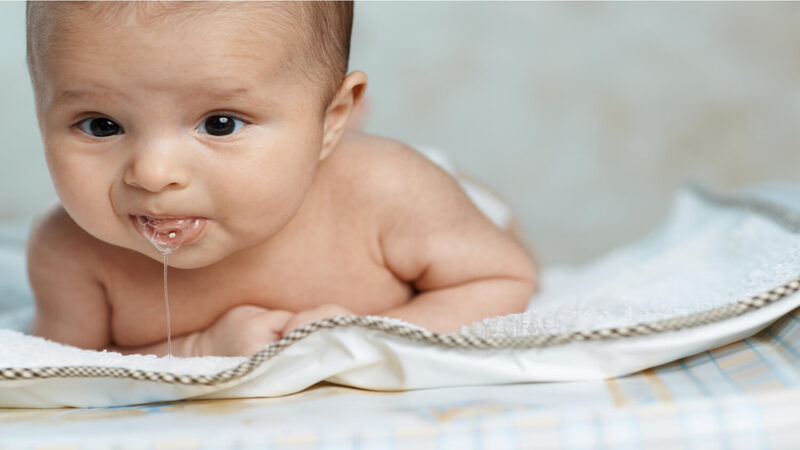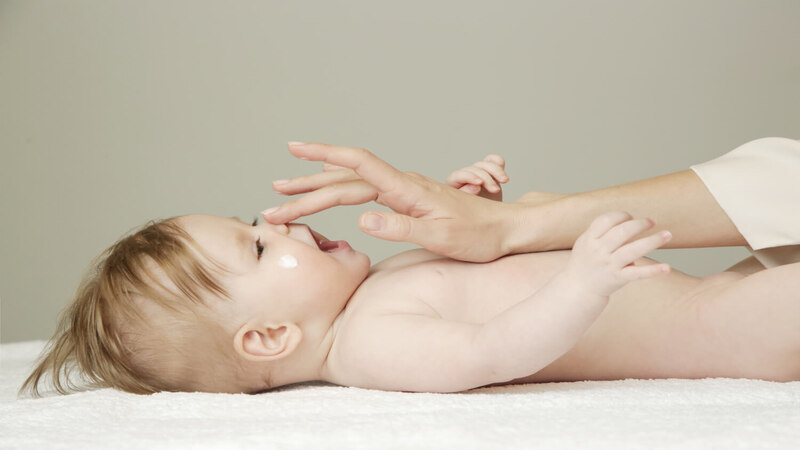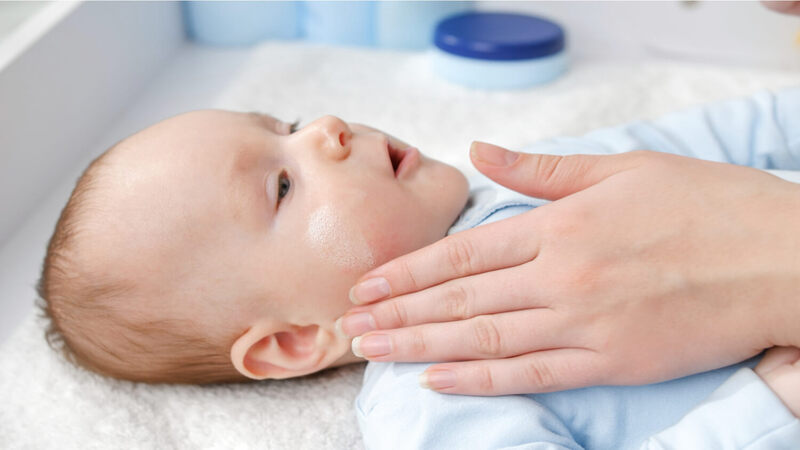
Noticed a reddish, itchy, chapped, irritating patch around your baby’s mouth and cheeks, sometimes extending to the folds of the neck and even to the chest? Babies often drool during their first few years, which can lead to drool rash. Typically, drooling decreases on its own as they grow older.
A drool rash develops when a baby’s sensitive skin is exposed to prolonged moisture and friction. Constant contact with saliva, milk, or food—combined with frequent wiping—can irritate the skin, breaking down its protective barrier. This irritation typically appears as red, inflamed patches that may feel rough or bumpy to the touch. Although harmless, drool rash can cause discomfort if not managed properly.
Video Of Easy Ways to Treat Drool Rash Effectively
What is a Drool Rash?
A drool rash, also known as dribble rash, occurs when the skin around a baby’s mouth and cheeks becomes sore due to excessive saliva, resulting in wet skin. In severe cases, the rash can extend to the folds of the baby’s neck and chest. It typically appears as slightly raised patches with small red bumps, which may or may not have tiny eruptions. This condition can irritate the delicate skin of infants, causing them discomfort.
What Causes a Drool Rash?
As babies drool, their saliva, which contains digestive enzymes, is often present on their skin. This constant moisture, when combined with friction from pillows, toys, or sheets, can lead to drool rash on a baby’s delicate skin. While drool rash is generally harmless, if left untreated, it can increase the risk of infection and develop into a condition known as impetigo, which is a contagious bacterial infection.
A baby’s skin is delicate and prone to rashes. Heat rash, eczema, and diaper rash are common among babies. (1) Therefore, identifying the exact cause of the rash can be difficult. Below are some possible causes of your baby’s drool rash.
Teething
Drooling often accompanies teething. Teething causes saliva from the inside of the mouth to drip down the sides of a child’s face. Sometimes it gets into the folds of their neck and even onto their chest. Drool rashes can develop in these areas.
Pacifiers
When your baby sucks on their pacifier, saliva drips from their mouth, causing drool to accumulate in the area. Saliva trapped by the pacifier prevents air from reaching it, which can lead to drool rashes.
Food
A drool rash may develop around your baby’s mouth if food residue is left on their face for too long.
How Can the Drool Rash in Babies be Prevented?

Prevention is always better than a cure. If the baby drools, the chances of them developing a drool rash are quite high. By taking some of the following preventive steps, we can decrease the chances of the baby getting a drool rash:
- Change your baby’s clothes as soon as they get wet with drool. Never allow it to remain damp, as this can lead to your baby developing a drool rash.
- Have a good supply of muslin cloths. Keep them within your reach and take them with you when you go out with your baby. Pat dry your baby’s skin as soon as the baby drools.
- Wipe your baby’s mouth and the folds of the neck thoroughly clean after every feed.
- By using an absorbent bib, which prevents the clothes and chin from becoming wet, you can also avoid drool rash in the baby.
- You can use a barrier cream as a preventive measure to keep the drool from directly touching the baby’s skin, especially during bedtime.
When a baby drools on the bed and rubs their face in the same spot, it can worsen drool rash. To help absorb the moisture, place a gentle, soft, and absorbent washcloth or towel underneath the bedsheet. Additionally, using a bib on the baby during the day can help keep their chest dry. Being attentive to your baby’s drooling is important for preventing drool rash and the potential infections that can result from it.
8 Home Remedies to Treat Drool Rash in Babies
There are several kinds of medicated creams to soothe the irritation caused to your baby due to a drool rash. Similarly, there are a number of home remedies to treat drool rash in babies. Some of them are mentioned below:
1. Wash
Wash the affected area with lukewarm water twice daily. The first wash should preferably be in the morning. Carefully pat dry the area. Never rub the area, as it will aggravate the redness and the irritation. Always use a gentle washcloth that absorbs the drool but does not irritate the skin of baby. Make sure that the washcloth is washed in mild detergent only.
[Read: Tips for Baby Bath]
2. Bathing
During the bath, always remember to use an unscented and mild baby wash. Do not use scented shampoo or soap as it can further irritate the rash. Never use baby lotion after bathing directly on the rash, even though you can use it in other areas. This is because the chemicals in the lotion can aggravate the rash. Always use a prescribed healing ointment or hydrocortisone cream only on the affected area of the baby.
3. Avoid Potential Irritants
Never use a chemical-based product on or near the affected area. The bedsheet the baby sleeps on, the pillow covers, his clothes, bibs, the muslin cloths used to dry the drools, etc., should be washed with fragrance-free mild laundry detergent. Also, wash your clothes with the same detergent as your baby will be in constant contact with you. Likewise, avoid using creams and lotions with harsh chemicals.
4. Use Protective Lotion and Ointment
After discussing the issue with your baby’s doctor, select an ointment or cream, preferably with lanolin, which is not harsh for your baby’s skin, to soothe the irritated skin. Make sure to apply only a thin layer so that it does not get into your baby’s hands or mouth, but covers the affected area properly. Make sure you use products that are safe for babies.
5. Use Skin Barriers
Vaseline petroleum jelly is a widely accepted moisturizer that is considered safe to apply to your baby’s skin. (2) It acts both as a moisturizer and an efficient skin barrier that prevents the drool from further contacting the irritated skin of the baby.
[Read: Top 10 Baby Skincare Tips]
6. Wipe It
Always wipe off the drool and change the drool-wet dress as soon as possible. Make sure that you gently wipe, thus avoiding the rash from getting worse. Do not use worn-out towels or washcloths to wipe, and make sure you are very gentle.
7. Aloe Vera Gel
Aloe vera is a plant that helps improve skin health. It has many useful properties, including reducing inflammation, protecting the skin, fighting bacteria and viruses, cleaning wounds, and promoting healing. (3). Pure aloe vera gel is also a popular home remedy for treating drool rash. Use it only after getting a green signal from the doctor.
8. Coconut Oil
Applying pure coconut oil on the affected area acts in two ways. Firstly, coconut oil serves as an excellent lubricant and alleviates irritation. Secondly, its antibacterial properties help prevent the risk of secondary infections.
If teething is the issue, provide your baby with something cold to chew on. Cold teething rings that have been sterilized are an excellent choice, but you can also use washcloths. These items will help soothe your baby’s sore gums and can also heal any rash. Be sure to clean them after each use and before giving them to your baby again.
When Should I Seek Medical Attention if My Baby Has a Rash?

If you notice that the rash is becoming worse, cracking, or causing pain and discomfort for the baby, it’s important to seek medical attention. If you have tried home remedies for a week without any improvement, take your child to the doctor. The doctor can prescribe medicated ointments and creams to promote faster healing. This will also help prevent the rash from worsening or developing into a more serious skin infection.
[Read: Difference Between A Baby Lotion And A Baby Cream?]
FAQ’s
1. Is it Normal For a Baby to Drool?
Yes, of course. Babies drool all the time. If your baby is drooling all over the place, don’t worry, they are fine.
2. When Will My Baby Stop Drooling?
That is hard to say. It depends on how and what you teach the child. Constant reminders can eventually help them stop.
3. Can The Drool Cause Rashes in My Baby?
Yes, it can. When the baby’s saliva pools around their face, it can cause a rash. The saliva also dries up on the face, causing rashes.
4. Will My Baby Drool When Teething?
Yes, they might. This is because teething aches and many keep their mouths open. They also like to bite on something to soothe their gums.
Read Also: Excessive Drooling in Children—Causes And Prevention
Reference
- Kutlubay Z, Tanakol A, Engýn B, Onel C, Sýmsek E, Serdaroglu S, Tuzun Y, Yilmaz E, Eren B. Newborn Skin: Common Skin Problems. – https://pmc.ncbi.nlm.nih.gov/articles/PMC5574071/
- Payvand Kamrani, Jamie Hedrick, James G. Marks, Andrea L. Zaenglein, Petroleum jelly: A comprehensive review of its history, uses, and safety, Journal of the American Academy of Dermatology, Volume 90, Issue 4, 2024, Pages 807-813, ISSN 0190-9622 – https://www.sciencedirect.com/science/article/abs/pii/S0190962223011076
- Hekmatpou D, Mehrabi F, Rahzani K, Aminiyan A. The Effect of Aloe Vera Clinical Trials on Prevention and Healing of Skin Wound: A Systematic Review – https://pmc.ncbi.nlm.nih.gov/articles/PMC6330525/
